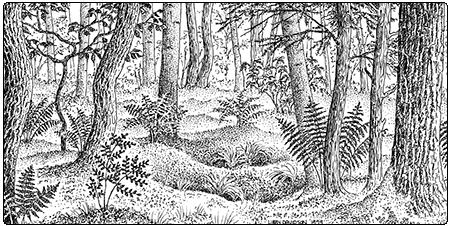Ecology and Physical Setting 
These intriguing wetlands, often simply called Black Gum Swamps, are more common to our south and are found only in the warmer climate areas of Vermont. Nestled within steep-sided, forested basins, these swamps have small watersheds and lack inlet streams. Outlet streams may flow seasonally. Red Maple-Black Gum Basin Swamps are typically the only wetland type in the basin. The water table is relatively stable, resulting in deep organic soils that are saturated throughout the growing season. Surface and near-surface waters in these swamps are very acidic. Bedrock typically underlies the deep peat. Hummocks and hollows are well developed, and the wettest hollows often contain shallow standing water.
Black gum has a distribution extending from southern Maine to southern Michigan and south to Florida and eastern Texas. In Vermont, black gum is uncommon, occuring mostly in Red Maple-Black Gum Basin Swamps in the southeastern and western parts of the state. It is also found occasionally in the Champlain Valley, where it occurs in this and other natural community types. Black gum is a very long-lived tree, reaching ages up to nearly 700 years in New England.
Vegetation

Mature black gum trees rising from the damp, mossy floor of these deep basin swamps are an amazing sight. The old trees may be two to three feet in diameter and have bark that is thick and deeply fissured into large rectangular blocks. The branching of these beautiful trees is distinctive. The larger branches of the trees droop and become very crooked with many short twigs at their ends.
Red Maple-Black Gum Basin Swamps have a fairly open canopy dominated by red maple and black gum. In some swamps, especially tall black gum trees extend above the canopy. Hemlock is a common canopy associate that can be abundant in some areas. Other trees include yellow birch, white pine, and red spruce. Downed and standing dead trees in various stages of decay are common. Trees are often shallow-rooted, but—because these swamps are in wind-sheltered basins—are less prone to windthrow than trees in some other swamp types.
The tall shrub layer is well developed and is typically dominated by highbush blueberry and winterberry holly. Mountain holly and mountain laurel, and saplings of the overstory trees, are also common. The understory is heavily shaded, and ferns thrive in the low-light conditions. Cinnamon fern is frequently dominant on the mossy hummocks, with lesser amounts of royal fern and marsh fern. The rare Massachusetts fern and Virginia chain fern are also associated with this community in Vermont. Growing with the ferns is a sparse cover of herbs, including three-seeded sedge, goldthread, partridgeberry, Canada mannagrass, and sarsaparilla.
Bryophytes blanket areas with moist hollows, but they are less abundant in areas where the hollows have permanent standing water. The tall hummocks are dominated by several species of sphagnum moss, especially Sphagnum palustre, Sphagnum magellanicum, and Sphagnum subtile. Lower hummocks may be covered by Sphagnum girgensohnii, and moist hollow species include Sphagnum angustifolium, Sphagnum fimbriatum, and Sphagnum squarrosum. Three-lobed bazzania, a leafy liverwort, is common on tall hummocks and well-rotted stumps.
Wildlife Habitat
Most of Vermont’s Red Maple-Black Gum Basin Swamps are mature, with large deciduous trees mixing with old hemlocks. This mixed forest provides important breeding habitat for Canada warblers. They prefer dense shrub layers and roots to conceal their nests, which are commonly built on sphagnum hummocks or within six inches of the ground. Northern parulas are closely tied to mature forests where old man’s beard and other epiphytic lichens grow. Lichens can be common on the large black gums and hemlocks of these swamps. Other breeding birds include northern waterthrush, winter wren, and veery. Black gum trees flower profusely in early summer. Reflective drops of nectar develop on the floral disc and have led to some calling these “sparkle flowers.” This nectar attracts several species of bees.
Beavers have long been a form of natural disturbance in swamps and other wetland types. But many of our Red Maple-Black Gum Swamps have ancient black gum and hemlock trees, indicating that beaver have not been active in these wetlands for as long as four to six hundred years. In recent years, beavers moved in to one of these swamps in southeastern Vermont. They selectively girdled and felled black gums, and dammed the outlet, flooding a portion of the swamp. This disturbance seems beyond the historic norm and may be the result of human pressure pushing beavers into marginal habitat. In cases like this, management of beavers is needed to protect the rare natural community.
Related Communities
- Red Maple-Sphagnum Basin Swamp is a similar and more widespread community. Black gum and other more southern species are absent.
- Hemlock-Sphagnum Basin Swamp is similar but is dominated by hemlock, along with a variable component of deciduous trees. Black gum is absent.
Conservation Status and Management Considerations
This is an extremely rare natural community in the state because black gum reaches its northern range limit in Vermont. Red Maple-Black Gum Basin Swamps are only known from the southeastern and western portions of the state where the climate is warm. In order to assure protection of the few examples in Vermont, it may be necessary to conserve the entire watershed in which each swamp is located. Development and heavy logging within the watershed of a Red Maple-Black Gum Basin Swamp would alter the quantity and quality of surface water runoff, which would have significant effects on the integrity of the swamp. Logging may also make these swamps susceptible to windthrow. Several fine examples of this community have been conserved in the J. Maynard Miller Town Forest in Vernon.
Distribution/Abundance
Red Maple-Black Gum Basin Swamps occur in the southeastern and western portions of Vermont. They also occur throughout southern New England and New York, with closely related communities found as far south as Virginia.
Characteristic Plants
Trees
Abundant Species
Red maple – Acer rubrum
Black gum – Nyssa sylvatica
Occasional to Locally Abundant Species
Eastern hemlock – Tsuga canadensis
Yellow birch – Betula alleghaniensis
White pine – Pinus strobus
Red spruce – Picea rubens
Shrubs
Abundant Species
Highbush blueberry – Vaccinium corymbosum
Winterberry holly – Ilex verticillata
Occasional to Locally Abundant Species
Mountain holly – Ilex mucronata
Mountain laurel – Kalmia latifolia
Herbs

is a rare plant of acidic basin swamps.
Abundant Species
Cinnamon fern – Osmundastrum cinnamomeum
Occasional to Locally Abundant Species
Royal fern – Osmunda regalis
Marsh fern – Thelypteris palustris
Three-seeded sedge – Carex trisperma
Goldthread – Coptis trifolia
Partridgeberry – Mitchella repens
Canada mannagrass – Glyceria canadensis
Sarsaparilla – Aralia nudicaulis
Bryophytes
Abundant Species
Moss – Sphagnum palustre
Moss – Sphagnum magellanicum
Occasional to Locally Abundant Species
Moss – Sphagnum subtile
Moss – Sphagnum girgensohnii
Moss – Sphagnum angustifolium
Moss – Sphagnum fimbriatum
Moss – Sphagnum squarrosum
Three-lobed bazzania – Bazzania trilobata
Moss – Amblystegium riparium
Moss – Hypnum imponens
Rare and Uncommon Plants
Massachusetts fern – Parathelypteris simulata
Virginia chain fern – Woodwardia virginica
Yellow bartonia – Bartonia virginica
Black gum – Nyssa sylvatica
Smooth winterberry – Ilex laevigata
Associated Animals
Great crested flycatcher – Myiarchus crinitus
Winter wren – Troglodytes hiemalis
Northern waterthrush – Parkesia noveboracensis
Canada warbler – Cardellina canadensis
Northern parula – Parula americana
Veery – Catharus fuscescens
Rare and Uncommon Animals
Four-toed salamander – Hemidactylium scutatum
Blue-spotted salamander – Ambystoma aterale
Places to Visit
J. Maynard Miller Town Forest, Vernon
Roaring Brook Wildlife Management Area, Vernon, Vermont Fish and Wildlife Department
Cold Brook Trail, Sunderland, Green Mountain National Forest
